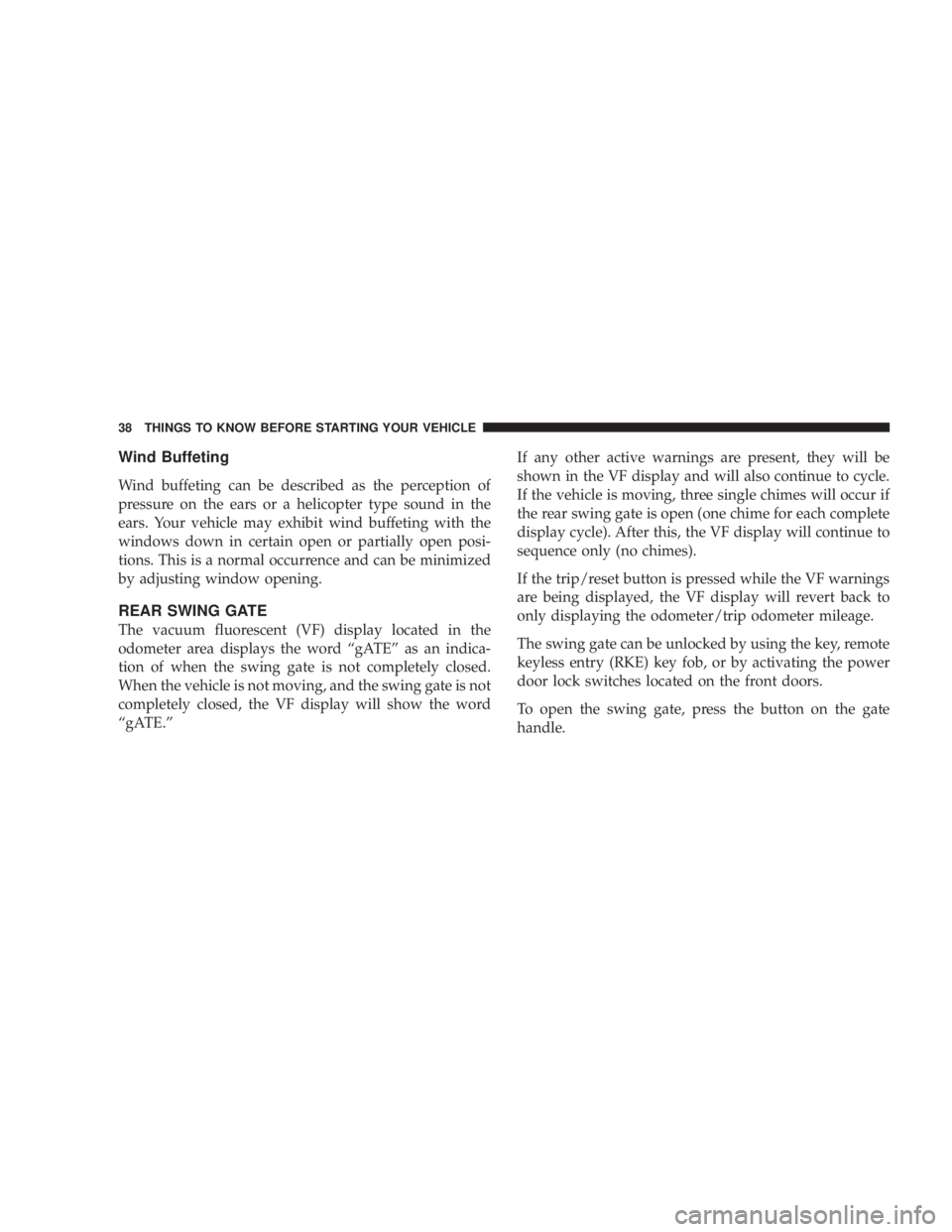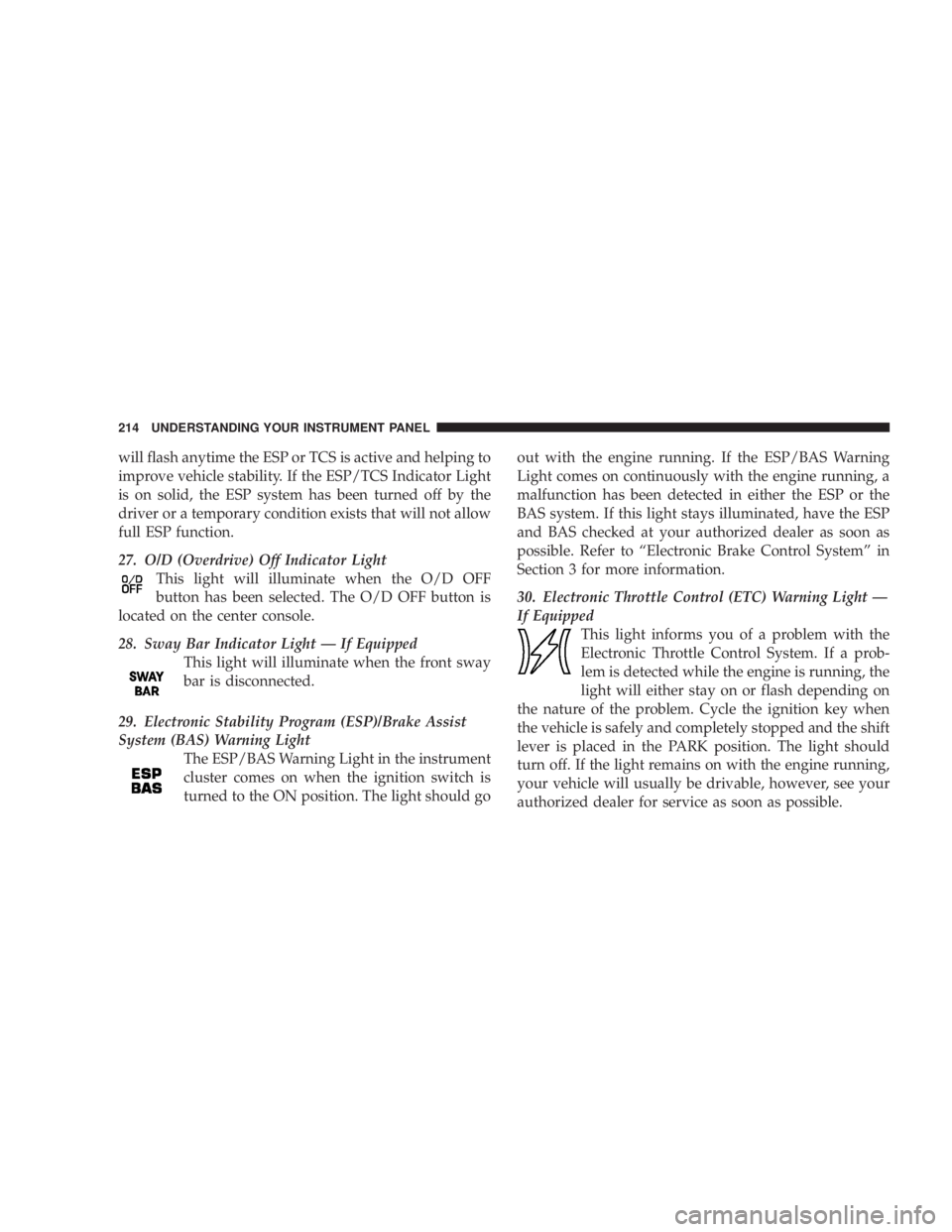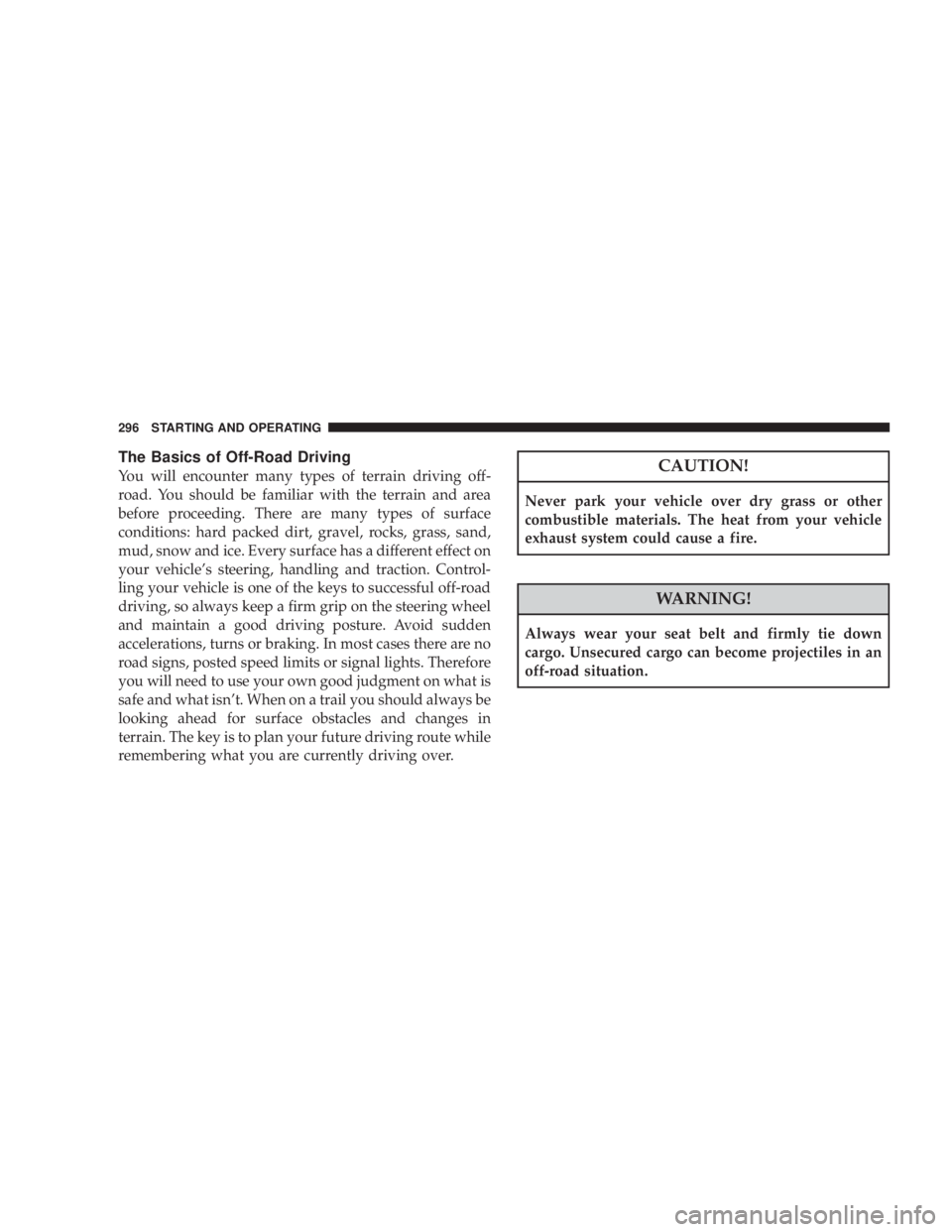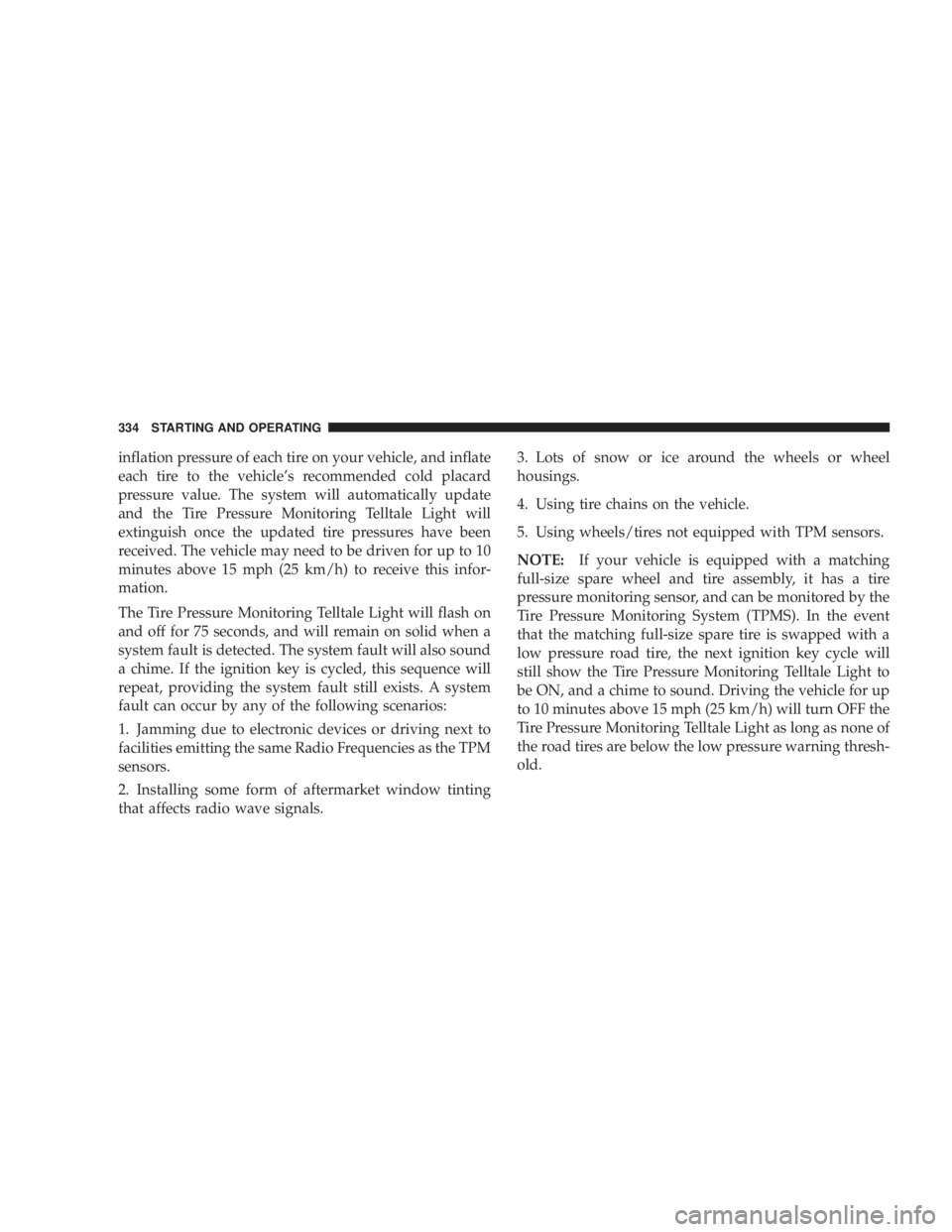key JEEP WRANGLER 2008 User Guide
[x] Cancel search | Manufacturer: JEEP, Model Year: 2008, Model line: WRANGLER, Model: JEEP WRANGLER 2008Pages: 466, PDF Size: 8.61 MB
Page 39 of 466

Wind Buffeting
Wind buffeting can be described as the perception of
pressure on the ears or a helicopter type sound in the
ears. Your vehicle may exhibit wind buffeting with the
windows down in certain open or partially open posi-
tions. This is a normal occurrence and can be minimized
by adjusting window opening.
REAR SWING GATE
The vacuum fluorescent (VF) display located in the
odometer area displays the word “gATE” as an indica-
tion of when the swing gate is not completely closed.
When the vehicle is not moving, and the swing gate is not
completely closed, the VF display will show the word
“gATE.”If any other active warnings are present, they will be
shown in the VF display and will also continue to cycle.
If the vehicle is moving, three single chimes will occur if
the rear swing gate is open (one chime for each complete
display cycle). After this, the VF display will continue to
sequence only (no chimes).
If the trip/reset button is pressed while the VF warnings
are being displayed, the VF display will revert back to
only displaying the odometer/trip odometer mileage.
The swing gate can be unlocked by using the key, remote
keyless entry (RKE) key fob, or by activating the power
door lock switches located on the front doors.
To open the swing gate, press the button on the gate
handle.
38 THINGS TO KNOW BEFORE STARTING YOUR VEHICLE
Page 119 of 466

Rear Cupholders
The rear cupholders are located on the back of the center
console.
STORAGE
Console Storage Compartment
To lock or unlock, insert ignition key and turn. To open,
press the latch and lift cover.
Page 215 of 466

will flash anytime the ESP or TCS is active and helping to
improve vehicle stability. If the ESP/TCS Indicator Light
is on solid, the ESP system has been turned off by the
driver or a temporary condition exists that will not allow
full ESP function.
27. O/D (Overdrive) Off Indicator LightThis light will illuminate when the O/D OFF
button has been selected. The O/D OFF button is
located on the center console.
28. Sway Bar Indicator Light — If Equipped This light will illuminate when the front sway
bar is disconnected.
29. Electronic Stability Program (ESP)/Brake Assist
System (BAS) Warning Light The ESP/BAS Warning Light in the instrument
cluster comes on when the ignition switch is
turned to the ON position. The light should go out with the engine running. If the ESP/BAS Warning
Light comes on continuously with the engine running, a
malfunction has been detected in either the ESP or the
BAS system. If this light stays illuminated, have the ESP
and BAS checked at your authorized dealer as soon as
possible. Refer to “Electronic Brake Control System” in
Section 3 for more information.
30. Electronic Throttle Control (ETC) Warning Light —
If Equipped
This light informs you of a problem with the
Electronic Throttle Control System. If a prob-
lem is detected while the engine is running, the
light will either stay on or flash depending on
the nature of the problem. Cycle the ignition key when
the vehicle is safely and completely stopped and the shift
lever is placed in the PARK position. The light should
turn off. If the light remains on with the engine running,
your vehicle will usually be drivable, however, see your
authorized dealer for service as soon as possible.
Page 281 of 466

Shift Lock Manual Override
Your vehicle may be equipped with a shift lock manual
override. The manual override may be used in the event
that the shift lever should fail to move from PARK with
the key in the ON position and the brake pedal de-
pressed. To operate the shift lock manual override, per-
form the following steps:
1. Firmly set the parking brake.
2. Using a flat blade screwdriver, carefully remove the
shift lock manual override cover which is located on the
PRNDL bezel, above the PARK position.
3. Depress and maintain firm pressure on the brake
pedal.
4. Using the screwdriver, reach into the manual override
opening. Press and hold the shift lock lever down.5. Depress the shifter release button and shift into NEU-
TRAL.
6. The vehicle may then be started in NEUTRAL.
Have your vehicle inspected by your local authorized
dealer, if the shift lock manual override has been used.
Page 297 of 466

The Basics of Off-Road Driving
You will encounter many types of terrain driving off-
road. You should be familiar with the terrain and area
before proceeding. There are many types of surface
conditions: hard packed dirt, gravel, rocks, grass, sand,
mud, snow and ice. Every surface has a different effect on
your vehicle’s steering, handling and traction. Control-
ling your vehicle is one of the keys to successful off-road
driving, so always keep a firm grip on the steering wheel
and maintain a good driving posture. Avoid sudden
accelerations, turns or braking. In most cases there are no
road signs, posted speed limits or signal lights. Therefore
you will need to use your own good judgment on what is
safe and what isn’t. When on a trail you should always be
looking ahead for surface obstacles and changes in
terrain. The key is to plan your future driving route while
remembering what you are currently driving over.
Page 299 of 466

Mud
Deep mud creates a great deal of suction around the tires
and is very difficult to get through. You should use 2nd
gear (manual transmission), or DRIVE (automatic trans-
mission), with the transfer case in the 4L (Low) position
to maintain your momentum. If you start to slow to a
stop, try turning your steering wheel no more than a 1/4
turn quickly back and forth for additional traction. Mud
holes pose an increased threat of vehicle damage and
getting stuck. They are normally full of debris from
previous vehicles getting stuck. As a good practice before
entering any mud hole, get out and determine how deep
it is, if there are any hidden obstacles and if the vehicle
can be safely recovered if stuck.
Sand
Soft sand is very difficult to travel through with full tire
pressure. When crossing soft sandy spots in a trail
maintain your vehicle’s momentum and do not stop. The
key to driving in soft sand is using the appropriate tirepressure, accelerating slowly, avoiding abrupt maneu-
vers and maintaining the vehicle’s momentum. If you are
going to be driving on large soft sandy areas or dunes,
reduce your tire pressure to a minimum of 15 psi (103
kPa) to allow for a greater tire surface area. Reduced tire
pressure will drastically improve your traction and han-
dling, while driving on the soft sand, but you must return
the tires to normal air pressure before driving on pave-
ment or other hard surfaces. Be sure you have a way to
reinflate the tires prior to reducing the pressure.
Page 305 of 466

WARNING!
If the engine stalls or you lose headway or cannot
make it to the top of a steep hill or grade, never
attempt to turn around. To do so may result in
tipping and rolling the vehicle, which may result in
severe injury. Always back carefully straight down a
hill in REVERSE gear. Never back down a hill in
NEUTRAL using only the vehicle brakes. Never
drive diagonally across a hill, always drive straight
up or down.
Driving Through Water
Extreme care should be taken crossing any type of water.
Water crossings should be avoided if possible, and only
be attempted when necessary in a safe responsible man-
ner. You should only drive through areas which are
designated and approved. You should tread lightly andavoid damage to the environment. You should know
your vehicles abilities and be able to recover it if some-
thing goes wrong. You should never stop or shut a
vehicle off when crossing deep water unless you ingested
water into the engine air intake. If the engine stalls, do
not attempt to restart it. Determine if it has ingested
water first. The key to any crossing is low and slow. Shift
into 1st gear (manual transmission), or DRIVE (automatic
transmission), with the transfer case in the 4L (Low)
position and proceed very slowly with a constant slow
speed {3 to 5 mph (5 to 8 km/h) maximum} and light
throttle. Keep the vehicle moving; do not try to accelerate
through the crossing. After crossing any water higher
than the bottom of the axle differentials, you should
inspect all of the vehicle fluids for signs of water inges-
tion.
304 STARTING AND OPERATING
Page 335 of 466

inflation pressure of each tire on your vehicle, and inflate
each tire to the vehicle’s recommended cold placard
pressure value. The system will automatically update
and the Tire Pressure Monitoring Telltale Light will
extinguish once the updated tire pressures have been
received. The vehicle may need to be driven for up to 10
minutes above 15 mph (25 km/h) to receive this infor-
mation.
The Tire Pressure Monitoring Telltale Light will flash on
and off for 75 seconds, and will remain on solid when a
system fault is detected. The system fault will also sound
a chime. If the ignition key is cycled, this sequence will
repeat, providing the system fault still exists. A system
fault can occur by any of the following scenarios:
1. Jamming due to electronic devices or driving next to
facilities emitting the same Radio Frequencies as the TPM
sensors.
2. Installing some form of aftermarket window tinting
that affects radio wave signals.3. Lots of snow or ice around the wheels or wheel
housings.
4. Using tire chains on the vehicle.
5. Using wheels/tires not equipped with TPM sensors.
NOTE:
If your vehicle is equipped with a matching
full-size spare wheel and tire assembly, it has a tire
pressure monitoring sensor, and can be monitored by the
Tire Pressure Monitoring System (TPMS). In the event
that the matching full-size spare tire is swapped with a
low pressure road tire, the next ignition key cycle will
still show the Tire Pressure Monitoring Telltale Light to
be ON, and a chime to sound. Driving the vehicle for up
to 10 minutes above 15 mph (25 km/h) will turn OFF the
Tire Pressure Monitoring Telltale Light as long as none of
the road tires are below the low pressure warning thresh-
old.
334 STARTING AND OPERATING
Page 455 of 466

Back-Up............................. 422
Brake Assist Warning ................. 1 15,214
Brake Warning ........................ 207
Bulb Replacement ...................... 420
Cargo ............................... 95
Center Mounted Stop ................... 423
Check Engine (Malfunction Indicator) ........ 213
Cruise .............................. 209
Daytime Running ....................... 99
Dimmer Switch, Headlight ................ 98
Electronic Stability Program (ESP)
Indicator ....................... 1 15,213,214
Electronic Throttle Control Warning ......... 214
Engine Temperature Warning .............. 209
Fog .............................. 99,422
Hazard Warning Flasher ................. 364
Headlight Switch ....................... 97
Headlights ........................... 420
High Beam ........................... 207 High Beam Indicator
.................... 207
Instrument Cluster ...................... 97
Interior .............................. 95
Lights On Reminder ..................... 98
Low Fuel ............................ 206
LowTire ............................ 210
Oil Pressure .......................... 207
Passing .............................. 99
Rear Servicing ........................ 422
Rear Tail ............................ 422
Seat Belt Reminder ..................... 207
Sentry Key ........................... 209
Service .............................. 420
Side Marker .......................... 422
Tire Pressure Monitoring (TPMS) ........... 210
Traction Control ....................... 213
Turn Signal ................... 99,207,421,422
Warning (Instrument Cluster Description) ..... 206
Loading Vehicle ......................... 342
454 INDEX
Page 459 of 466

Restraints, Child....................... 62,67
Restraints, Occupant ...................... 40
Roll Over Warning ........................ 5
Rotation, Tires .......................... 329
Safety Checks Inside Vehicle ................. 76
Safety Checks Outside Vehicle ............... 77
Safety Defects, Reporting .................. 440
Safety Information, Tire ................... 313
Safety Tips ............................. 75
Satellite Radio .................... 250,251,253
Satellite Radio Antenna ................... 255
Schedule, Maintenance .................... 428
Seat Belt Reminder ....................... 49
Seat Belts .............................. 41
Adjustable Upper Shoulder Anchorage ........ 47
And Pregnant Women ................... 50
Child Restraint ....................... 62,72
Extender ............................. 50 Front Seat
............................ 41
Maintenance .......................... 411
Pretensioners .......................... 48
Reminder ............................ 207
Seats ................................. 86
Adjustment ........................... 86
Cleaning ............................ 409
Easy Entry ............................ 88
Fold and Tumble Rear ................... 89
Head Restraints ........................ 89
Height Adjustment ...................... 87
Rear Folding .......................... 92
Removal ........................... 91,92
Seatback Release ....................... 87
Tilting ............................... 87
Security Against Theft ..................... 18
Security Alarm (Theft Alarm) ................ 18
Selection of Oil ......................... 384
Sentry Key (Immobilizer) ................... 14
458 INDEX